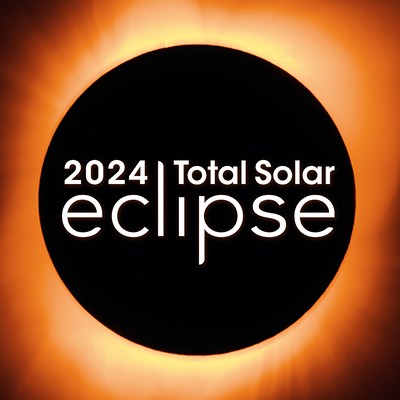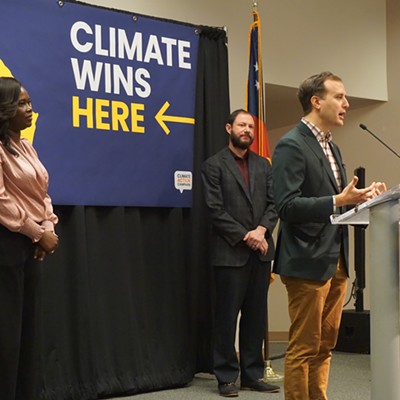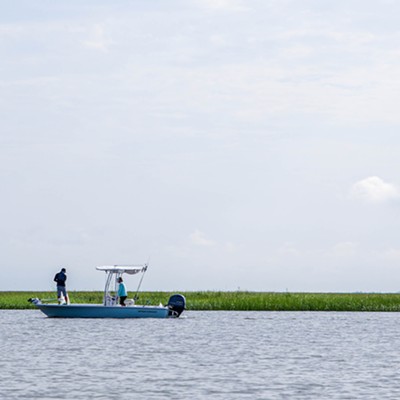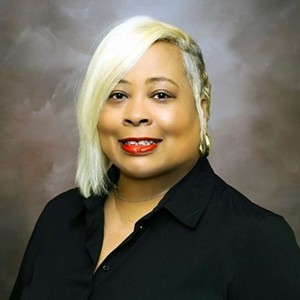Addressing a roomful of Rotary Club members at the Desoto Hilton in Savannah recently, Representative John Barrow opened up a nuclear can of worms for a couple of environmentalists in the crowd.
Defending the expansion of Southern Company's Vogtle electric generating plant on the Savannah River, Rep. Barrow told his captive audience that nuclear power is the answer to Georgia's growing energy needs, and is the only technology on the shelf that doesn't emit pollution.
"That's just not true," Steve Willis, chair of Center for a Sustainable Coast, said to Barrow privately, after his speech. Willis went on to talk about wind and solar, giving arguments for each: solar resources in Georgia are 60 percent greater than in Germany, the world leader in solar energy generation.
"Don't even get me going on wind," said Willis, barely taking a breath. "Wind-generated electricity is already about half as expensive per kilowatt-hour as Georgia Power's nuclear proposal at Plant Vogtle." Barrow nodded looking at his watch.
But, perhaps what was most disturbing was Barrow's contention that nuclear power doesn't emit pollution.
"What I meant to say is that nuclear power is carbon neutral," said Barrow, correcting himself.
It's an important correction to make-too bad the roomful of people didn't hear it-seeing that nuclear power plants release radioactive effluent. In Vogtle's case, that effluent winds up in the Savannah River.
Frank Carl, executive director of the Savannah Riverkeeper, has written that the Savannah is "the most tritium-contaminated environment in the U.S."
"But that's mostly legacy waste" said Barrow.
True, much of the tritium and other radioactive pollutants in the river originate from the Department of Energy's Savannah River Site (SRS), just across the river from Vogtle, but it is the combination of Vogtle and SRS releases that give the Savannah the continuing distinction of a radioactively polluted river.
Due to "industrial and radioactive pollution," the Sierra Club named the Savannah River one of the 52 most endangered places in the country in 2007.
Yet, so far, all lights are green to build two more reactors alongside the river, pumping more tritium into the Savannah, just as downstream users become more dependent on the source for drinking water.
But tritium levels are below EPA limits, Barrow pointed out.
In an article I wrote for this newspaper in September 2007 on the SRS leaks and releases of tritium, I interviewed a number of scientists. Dr. Richard Lee, professor and radiation safety officer at the Skidaway Institute of Oceanography, said that there is no problem drinking tritium-laced water.
"Of all the radioactive material, it is the least harmful," he said.
But he went on to say that if you look into the history of how allowable levels of radioactive compounds in drinking water were set, "you'll find that they were pretty arbitrary."
Places like California have established Public Health Goals for tritium in drinking water that are fifty times more stringent than the EPA's allowances.
But Barrow doesn't hear from his constituents on the issue, and you know the old saying about the squeaky wheel ...
Even if the people of the Savannah River basin don't speak out, isn't there something wrong with adding more radioactive pollution-emitting facilities to an already compromised river?
Never mind that President Obama has cut funding for Yucca Mountain, leaving no nuclear waste repository for the over one hundred nuclear power plants in the country, let alone the dozen that are in the planning stages. Where will the high-level waste go?
Never mind that the two currently operating Vogtle plants are some of the largest in the country, together using some 85 million gallons of water from the Savannah River per day, jeopardizing river flow.
Never mind that the Public Service Commission, Georgia General Assembly and the governor all voted to allow Southern Company to collect $1.6 billion from ratepayers six years before the reactors are due to be complete. (Who's running this state anyway?)
Never mind that Southern Company's political action committees and executives rank among the largest contributors of national and state campaign contributions. Note: Ed Holcombe, former Southern Company Vice President in charge of government affairs, is currently Gov. Perdue's Chief of Staff. (I guess that's who's running the state.)
Never mind that the Vogtle expansion costs are likely to balloon beyond the $14 billion estimate. Note: the two original Vogtle plants cost 20 times the original estimate.
Never mind that Southern Company has successfully had the law changed so that cost overruns are recoverable, with a built-in 12 percent profit margin, by raising rates to its customers.
Never mind that Southern Company sells its excess electricity outside the state.
Never mind that the construction of the plants will require the Savannah River to be dredged 150 miles upstream. The Nuclear Regulatory Commission's Atomic Safety & Licensing Board agrees with environmental groups that dredging would have significant impacts on the river that must be addressed before final approval is granted.
Never mind that Southern Company ignores conservation measures like smart meters and renewable options like solar and wind, as our neighboring states, and in fact, the rest of the country, move forward with these energy advancements.
Never mind that a resolution put before the Georgia Assembly on environmental justice states: "Radiological monitoring programs reveal that Savannah River fish, particularly resident game fish species, are contaminated with cesium 137. Large mouth bass are contaminated with cesium 137 and are a target species of subsistence fishermen on the Savannah River. Recreationally important fish species in the vicinity of Plant Vogtle routinely have been found to have detectable levels of cesium 137 in the edible flesh of collected samples."
However, there is something downstream water users should mind.
If the Savannah River were in California, it would fail its Public Health Goal for tritium levels in drinking water. This goal was set using the EPA document Cancer Risk Coefficients for Environmental Exposure to Radionuclides.
The Savannah is the only river in the United States with a Department of Energy tritium manufacturing facility and two nuclear power plants on its banks. And after the expansion of two more reactors, it will be the largest nuclear power generating facility in the country.
According to the Nuclear Regulatory Commission's Early Site Permit Environmental Impact Statement for the Vogtle expansion, "radiation protection experts conservatively assume that any amount of radiation may pose some risk of causing cancer or a severe hereditary effect and that the risk is higher for higher radiation exposures. Simply stated, any increase in dose, no matter how small, results in an incremental increase in health risk."
Most Americans do not share the Savannah River communities' acceptance of nuclear waste. A 2007 survey by the Massachusetts Institute of Technology Center for Advanced Nuclear Energy Systems found 54 percent of Americans believe nuclear power was very harmful or moderately harmful to the environment.
"Until people start to speak out nothing is going change here," said Willis, walking away from the Barrow event. "It will be the same old politicians and more and more pollution."























